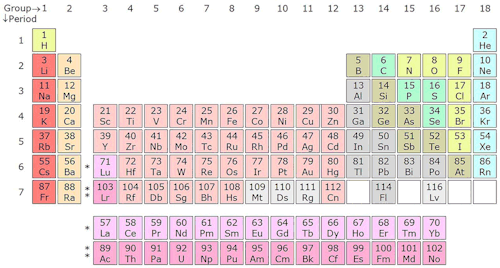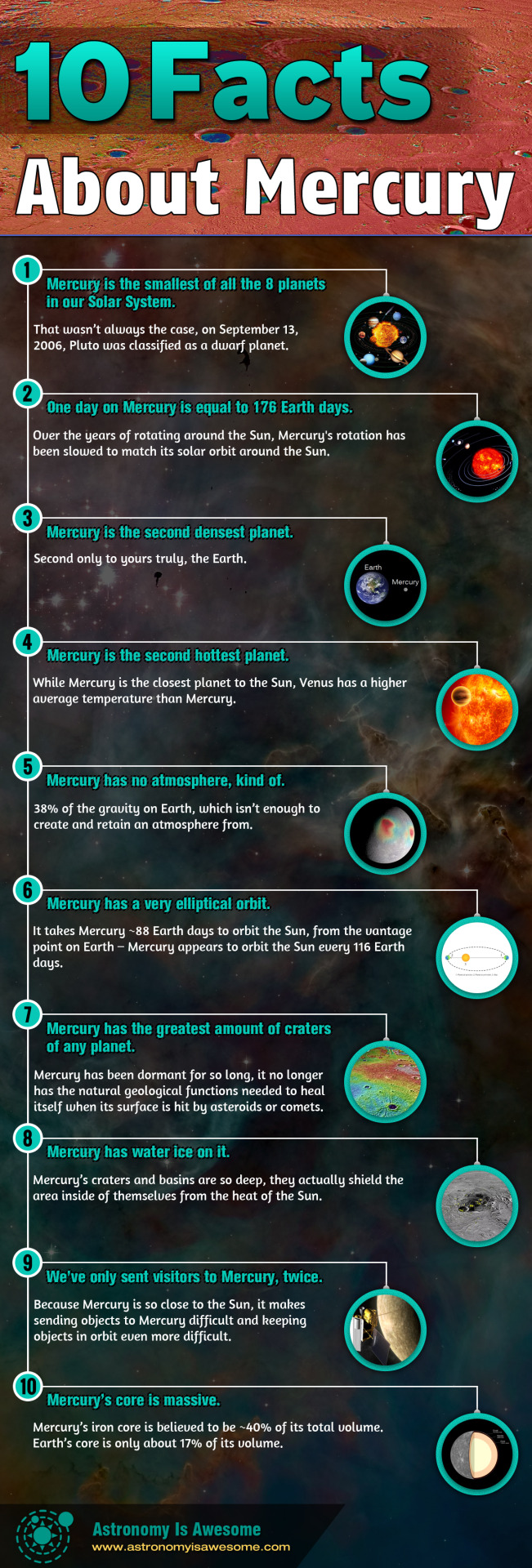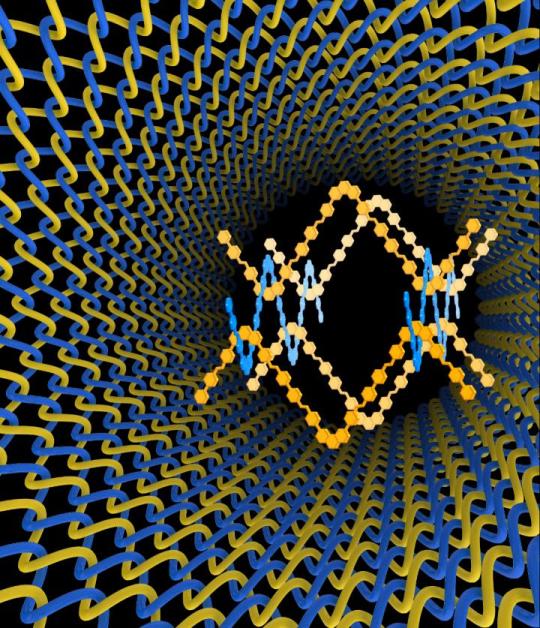Check Out Our Infographic On Venus Here: http://astronomyisawesome.com/infographics/10-facts-about-venus/

Check out our infographic on Venus here: http://astronomyisawesome.com/infographics/10-facts-about-venus/
More Posts from Smartler and Others

Scientists in Japan, Russia and the US have discovered four new elements, which means the seventh row of the Periodic table is finally filled!! WAY TO GO SCIENCE!!









Solving the data processing alone is mindnumbing…
The amount of sensory information collected pose a huge storage problem and require real-time signal processing to reduce the information to relevant data. In mid 2011 it was estimated the array could generate an exabyte a day of raw data, which could be compressed to around 10 petabytes.
Square Kilometre Array
The Square Kilometre Array (SKA) is a radio telescope project that will be built in Australia and South Africa. It will have a total collecting area of approximately one square kilometre. It will operate over a wide range of frequencies and its size will make it 50 times more sensitive than any other radio instrument.
The Square Kilometre Array SKA
Gotta love science ❤️









– Isaac Asimov, 1922 - 1992
On a scale of Matt Damon

to Matt Damon

how well do you handle being stuck alone on an inhospitable planet

Check out our Infographic on Mercury here: http://astronomyisawesome.com/infographics/10-facts-about-mercury/







The last, but not least of starry scholastic month!
This week’s entry: Black Holes
http://www.space.com/15421-black-holes-facts-formation-discovery-sdcmp.html
http://www.space.com/19339-black-holes-facts-explained-infographic.html
Wildest Dreams (Piano Instrumental)
Credit to Molotov Cocktail
😭
all too well was requested so i decided to try something different.
imagine: all too well as a voicemail.
use headphones
5 Extraordinary & Mind Blowing Sea Creatures
This video was produced by the Youtube channel Top5s
The animals featured in this video are the frilled shark, the mantis shrimp, the giant isopod, the mimic octopus, and finally a mysterious long legged squid.
I decided to share this video on this blog because Top5s did a wonderful job of introducing these incredible, odd, and sometimes unsettling animals without using drama or fear to as a way to gain views or anything else. I really appreciate the straight forward method he takes when discussing things like this. He gets the information out and still keeps the viewer interested without fear mongering.
If/when he posts more ocean related videos I’ll be sure to share them, for now if you are interested to see any of his other videos (he covers a variety of subjects. Many of them odd, strange, and/or disturbing: you’ve been warned) here’s a link to his channel Top5s:
https://www.youtube.com/channel/UCX51Dixddr5HuwLVBH9ykeQ

There are many different ways to make nanomaterials but weaving, the oldest and most enduring method of making fabrics, has not been one of them – until now. An international collaboration led by scientists at the U.S. Department of Energy (DOE)’s Lawrence Berkeley National Laboratory (Berkeley Lab) and the University of California (UC) Berkeley, has woven the first three-dimensional covalent organic frameworks (COFs) from helical organic threads. The woven COFs display significant advantages in structural flexibility, resiliency and reversibility over previous COFs – materials that are highly prized for their potential to capture and store carbon dioxide then convert it into valuable chemical products.
“We have taken the art of weaving into the atomic and molecular level, giving us a powerful new way of manipulating matter with incredible precision in order to achieve unique and valuable mechanical properties,” says Omar Yaghi, a chemist who holds joint appointments with Berkeley Lab’s Materials Sciences Division and UC Berkeley’s Chemistry Department, and is the co-director of the Kavli Energy NanoScience Institute (Kavli-ENSI).
“Weaving in chemistry has been long sought after and is unknown in biology,” Yaghi says. “However, we have found a way of weaving organic threads that enables us to design and make complex two- and three-dimensional organic extended structures.”
Continue Reading.
-
 cernunnos1990 liked this · 3 years ago
cernunnos1990 liked this · 3 years ago -
 ineedspacex-blog reblogged this · 9 years ago
ineedspacex-blog reblogged this · 9 years ago -
 tiredhamilton-blog reblogged this · 9 years ago
tiredhamilton-blog reblogged this · 9 years ago -
 synthcabbit reblogged this · 9 years ago
synthcabbit reblogged this · 9 years ago -
 synthcabbit liked this · 9 years ago
synthcabbit liked this · 9 years ago -
 intheendwinsthedeath liked this · 9 years ago
intheendwinsthedeath liked this · 9 years ago -
 ruinsofcrosskeys liked this · 9 years ago
ruinsofcrosskeys liked this · 9 years ago -
 nebulouscorvid reblogged this · 9 years ago
nebulouscorvid reblogged this · 9 years ago -
 caconyms liked this · 9 years ago
caconyms liked this · 9 years ago -
 faidincorner liked this · 9 years ago
faidincorner liked this · 9 years ago -
 aaronwatershow reblogged this · 9 years ago
aaronwatershow reblogged this · 9 years ago -
 howstrangethemusicsoundstome reblogged this · 9 years ago
howstrangethemusicsoundstome reblogged this · 9 years ago -
 howstrangethemusicsoundstome liked this · 9 years ago
howstrangethemusicsoundstome liked this · 9 years ago -
 anasegurap liked this · 9 years ago
anasegurap liked this · 9 years ago -
 faelyn315-blog liked this · 9 years ago
faelyn315-blog liked this · 9 years ago -
 lizhonghui16-blog liked this · 9 years ago
lizhonghui16-blog liked this · 9 years ago -
 stoptheclocksforyouandme reblogged this · 9 years ago
stoptheclocksforyouandme reblogged this · 9 years ago -
 vlad2184 liked this · 9 years ago
vlad2184 liked this · 9 years ago -
 aceacetrainerace reblogged this · 9 years ago
aceacetrainerace reblogged this · 9 years ago -
 princeshinysylveon reblogged this · 9 years ago
princeshinysylveon reblogged this · 9 years ago -
 pexilexi liked this · 9 years ago
pexilexi liked this · 9 years ago -
 relz1 liked this · 9 years ago
relz1 liked this · 9 years ago -
 meli-kc liked this · 9 years ago
meli-kc liked this · 9 years ago -
 nasapleasehireme reblogged this · 9 years ago
nasapleasehireme reblogged this · 9 years ago -
 kuungjaada liked this · 9 years ago
kuungjaada liked this · 9 years ago -
 takemyfall reblogged this · 9 years ago
takemyfall reblogged this · 9 years ago -
 ninjabunny21-blog liked this · 9 years ago
ninjabunny21-blog liked this · 9 years ago -
 raefactor reblogged this · 9 years ago
raefactor reblogged this · 9 years ago -
 rathruby liked this · 9 years ago
rathruby liked this · 9 years ago